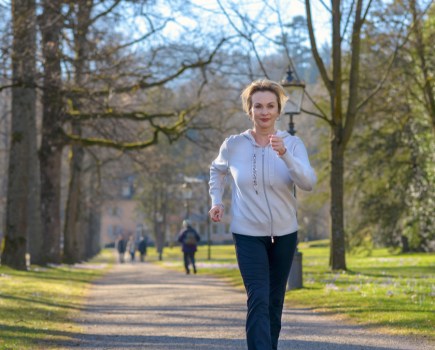What is type 2 diabetes? Find out about the causes, diagnosis methods, and treatments.
Type 2 diabetes is a medical condition that affects your blood sugar and is caused by problems with your body’s ability to either produce insulin or to respond to the insulin your body does produce. Insulin is a hormone that is made in your pancreas and its key role is processing the glucose you get from your food.
It works like this – normally, when you eat food it is broken down and glucose is produced, then your insulin helps that glucose to go from your bloodstream to your cells. That’s important because it helps you produce the energy you need. If you have diabetes this process doesn’t happen as it should, and so glucose builds up in your bloodstream.
There are two main types of diabetes, known as type 1 and type 2. However, the most common one is type 2 – according to the NHS website, 90 per cent of people with diabetes have type 2.
Complications can happen if your diabetes is not managed well. Hypoglycaemia, hyperglycaemia, HHS and a whole range of health conditions including vision loss and infections of the feet, can crop up, so it is important to monitor your type 2 diabetes, your general health and your lifestyle closely. It is vital to deal with these issues promptly if they arise.
Read on to find out more about the condition. However, this is no substitute for medical advice, so if you think you may have type 2 diabetes, it is important that you see your GP to get a diagnosis and, if you do have it, to talk through the possible treatments and find the right solution for you.
What is type 2 diabetes?
It happens when your body does not produce enough insulin, or it does make it, but it doesn’t work properly because your body doesn’t respond to it as it should. This causes your blood sugar to rise, because it is not being processed in the usual way. Increased blood sugar can cause your body to make more insulin. For some people this can eventually cause your pancreas to become less effective and produce less insulin. Type 2 diabetes is a serious condition and left untreated can cause complications that affect other parts of the body such as your heart, eyes and feet.
What causes type 2 diabetes?
There are a number of risk factors for type 2 diabetes, and these include being overweight especially if you’re carrying that extra weight around your tummy. Being inactive and having high blood pressure are also factors that may increase your risk.
However, there are other risk factors that you can’t do anything about. Some people ask if it is genetic? In fact, having siblings or a parent with the condition does put you more at risk of getting type 2 diabetes.
People of South Asian, African-Caribbean or Black African descent are also at increased risk. According to the Diabetes UK website, you are between two and four times more likely to get type 2 diabetes if you are from these groups.
Your risk also increases with age – and there’s not much you can do about that!
You can find out more about your level of risk of type 2 diabetes by using a know your risk tool online. There is one on the Diabetes UK website and also on the NHS website
What are the symptoms of diabetes?
There are early warning signs of type 2 diabetes. If you have a number of these, go to speak to your GP.
- Needing to urinate more often than usual, especially at night-time.
- Increased thirst
- Feeling extra tired
- Experiencing blurred vision.
- Recurring cases of thrush or itching around your genitals
- Cuts and grazes that don’t seem to heal
- Losing weight without really trying to
However, many people have it without even realising it, as the effects don’t necessarily make them feel unwell. It is vital to see a doctor promptly if you experience symptoms of diabetes or suspect you have it, as it is a serious condition.
So, if you have symptoms, get them checked out!
How is type 2 diabetes diagnosed?
If you are experiencing symptoms of type 2 diabetes, see your GP. They can test your blood and urine.
Sometimes type 2 diabetes is picked up when health professionals are carrying out blood and urine tests for other health conditions.
There is another condition that may be found, which is often described as ‘pre-diabetes’. This is where your blood sugar is higher than it should be, but you are not actually diabetic. Having pre-diabetes means your risk of getting an actual type 2 diabetes diagnosis is increased, so it’s a warning that is well worth heeding.
If it turns out that you do have the condition your doctor will talk you through the next steps.
How is type 2 diabetes treated?
Treatments are different for different people. In the early stages, lifestyle changes such as improving diet and activity levels may be the first approach, but medication may be prescribed if it’s too far developed. However, lots of people have reversed their type 2 diabetes with a low-carb diet.
Diet
People with the condition benefit from eating a healthy and varied range of foods including vegetables but limiting fruit, especially the more sugary ones such as apples and pears. Berries are the lowest in sugar as are citrus fruits. When it comes to carbs it is best to go for those that have a low glycaemic index (GI) such as whole grains, but lots of nutritionists advise reducing all types of carbs at least initially if you are trying to reverse diabetes. Keeping sugar to a minimum is very important.
Exercise
Being active helps your body in a number of ways including increasing insulin sensitivity and reducing some of the other risk factors such as excess weight and high blood pressure.
Medication
Most people with this condition will have to take medicine to help lower the amount of sugar in the blood. According to the NHS website, Metformin is usually offered first, but there are other medications that may be used. Although insulin will not often be used in the early stages, it may be needed later on if other medications stop working.
Can I prevent type 2 diabetes?
If you are at risk of developing the condition there are things you can do to give yourself the best chance of avoiding it.
- When eating carbs, choose wholefood carbs that are unrefined, such as millet, quinoa, buckwheat.
- Eat fruit and veg in their whole form, rather than as a juice.
- Eat healthy fats such as avocados, oily fish and seeds.
- Keep sugar to a minimum by avoiding too much alcohol, as well as sweets, cakes and pastries.
- Keep on moving. A sedentary lifestyle is a risk factor, so move more. Make sure it’s something that you can keep up with so do something you enjoy such as dancing, gardening or going out on a good walk – whatever works for you.
- Maintain a healthy weight. Being overweight is a risk factor too, so if you need to lose weight take action on that. Improving your diet and introducing more activity into your life will certainly help with this.
To find out more, why not visit the NHS website or go to the Diabetes UK site?








